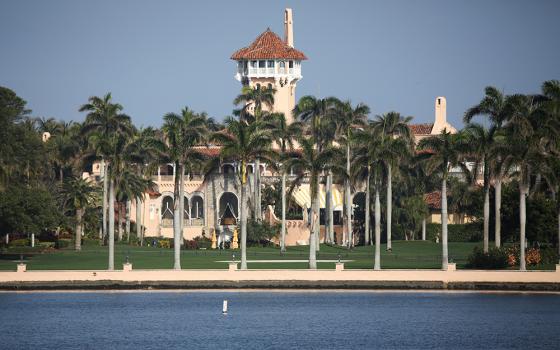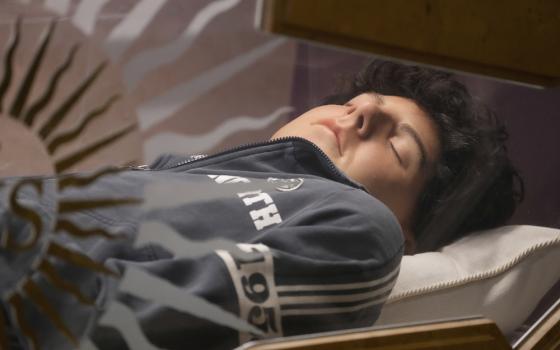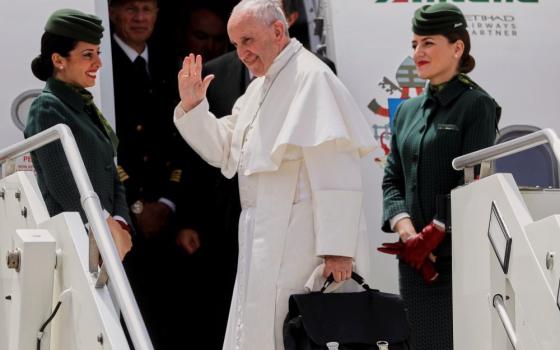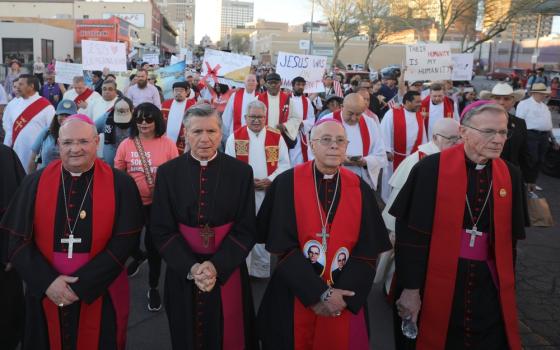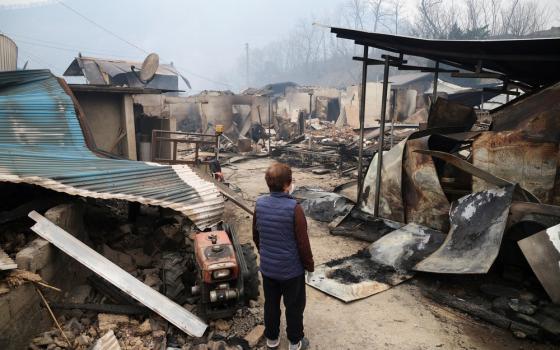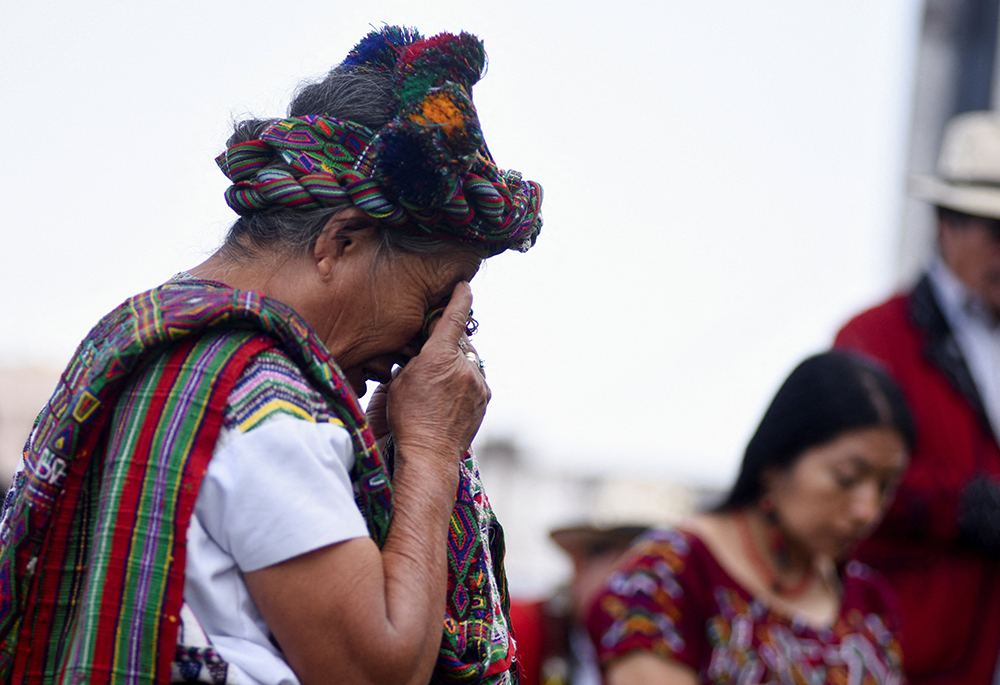
Ana de Leon, from the Maya Ixil people and a survivor of the internal armed conflict, reacts while participating with others in a ritual, outside the Supreme Court and prior to a hearing in the Maya Ixil genocide trial, March 25 in Guatemala City, Guatemala. (OSV News/Reuters/Cristina Chiquin)
No matter what you knew about the genocide case against Gen. Benedicto Lucas García at the beginning of the trial here in April, the enormity of what happened — the murders and destruction — hits home only after hearing nearly a hundred accounts by survivors, psychologists, and forensic scientists who disinter remains from mass graves.
Nonetheless, experts debate whether acts committed during the counterinsurgency led by Lucas between 1978 and 1982 should be called genocide, or termed "war crimes." The question is important both to victims and those who pursue justice for crimes of the past.
Whatever the horror is called, and whether or not the three-judge court here finds the general guilty in the coming weeks, what happened during the bloody campaign wrought fundamental change in human lives that appears to be irreversible. Thousands of unarmed civilians were killed in the Indigenous Ixil Maya heartland northwest of this capital and a living ancient culture was purposefully smashed at its roots. A forward-looking social movement that had been improving rural lives was violently truncated.
And a vibrant Catholic faith and practice that emphasized the dignity of the individual, no matter how poor, was brutally erased.
What happened in the region called the Ixil Triangle went beyond mass murder, testified Eyal Weizman, director of Forensic Architecture at Goldsmiths, University of London, a research group. Weizman examines places where mass rights violations have occurred using on-site visits — termed "ground truth" — and scientific tools such as aerial photography for Amnesty International, the International Committee of the Red Cross and the United Nations.
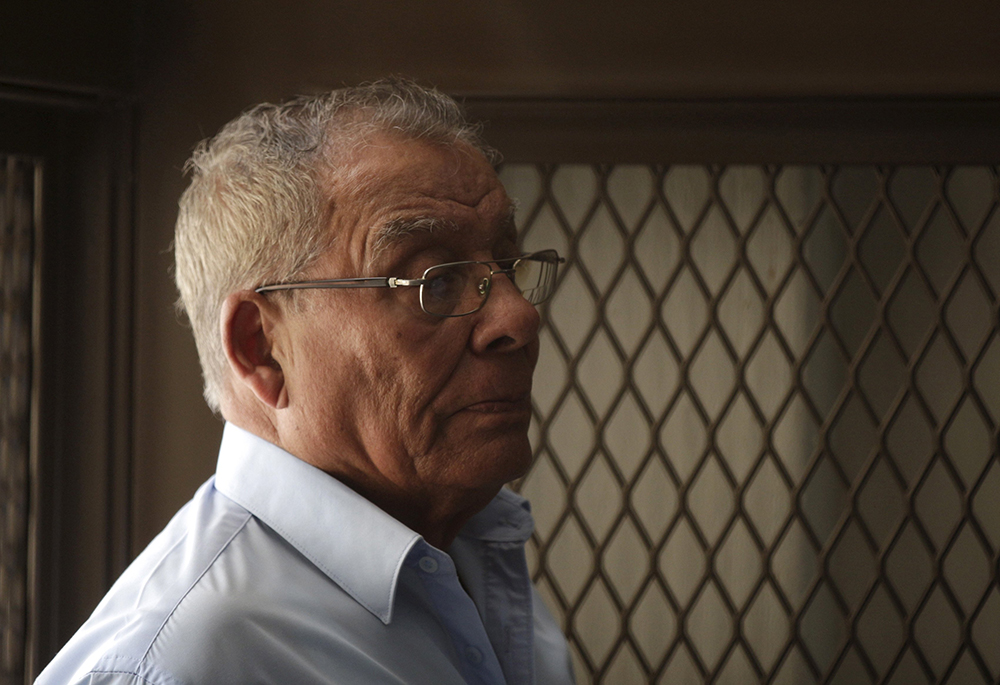
Retired Guatemalan general Benedicto Lucas García stands in a cage during a hearing at the Supreme Court of Justice Jan. 8, 2016, in Guatemala City. Lucas has gone on trial April 8 for genocide, offering an opportunity for justice for aging victims of targeted attacks on Indigenous villages during the country’s armed conflict. (OSV News/Reuters/Josue Decavele)
Lucas' counterinsurgency campaign, waged during a 36-year internal armed conflict that ended in 1996 in which some 200,000 died, obliterated entire villages and razed their forest holds. Weizman called it "cultural extermination, genocidal in nature, destruction and reconstruction, including a series of strategies aimed at the complete transformation of the place where they lived." Altering the environment was key to the destruction of Ixil culture. Forest sites were cut down or burned, making it impossible for inhabitants to search out their medicinal and ceremonial plants, or go to certain sacred places to practice traditional rites, known as costumbre.
Survivors were gathered into concentration camps that resembled the "strategic hamlets" used during the U.S. war in Vietnam to separate the population from guerrillas. Sometimes called "model villages," where the military ruled, they "gave rise to a population conducive to state control," Weizman told the court. Maya residents no longer made decisions through traditional elders but went to the comandante, who might give permission to marry, for instance, or travel outside the settlement.
Visiting the concentrations in the mid-1980s, I found them silent and tense compared to other Maya villages in the country. Houses were crowded together, uniformly placed, not scattered about* with repurposed powdered milk tins out front holding flowers, and yards lively with goats and pigs. No friendly greetings to the visitor. No oratorios (Catholic chapels), ubiquitous elsewhere.
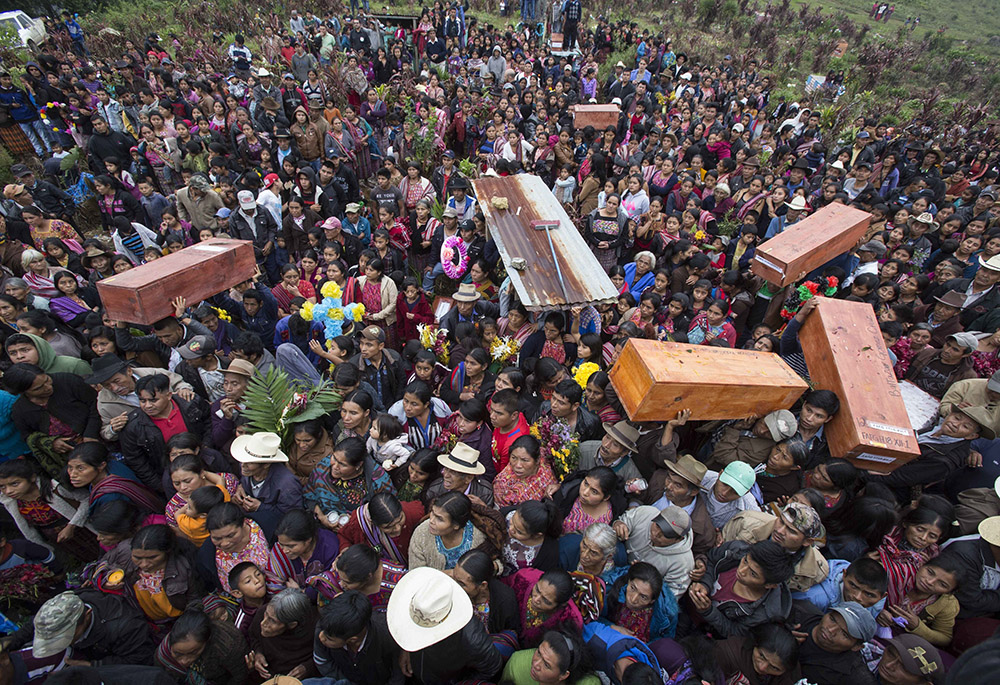
In this Nov. 30, 2017 photo, locals carry the remains of family members who were killed during the civil war, to finally be buried in Santa Avelina, Guatemala. In 1980 the army formed one of the first model villages in Santa Avelina, located in the heart of Ixil territory in the department or province of Quiche. But without access to doctors, a healthy diet and freedom, people began to die. (AP photo/Luis Soto)
One major camp, Salquil Grande, counted 15 evangelical churches, many United States-based, welcomed by the army as an alternative to the Catholic Church — which it considered a supporter of leftist subversion. Elsewhere, I rarely saw them.
"All meetings were suspect except for those of evangelical groups," testified psychologist Carlos Paredes, who interviewed survivors. Forced patrols of civilian men and boys, instituted by Lucas, policed village limits and each other. Paredes said that he perceived among survivors a "loss of hope for the future, networks destroyed," conditions "felt until today."
Weizman, an Israeli forensic architect, said his family experienced genocide in the Nazi era when his grandparents escaped Auschwitz. Trauma experienced by Maya survivors, he testified, may be another ineradicable consequence of the violent campaign with an "intergenerational effect" felt by future Ixil.
In the 1950s, Archbishop Mariano Rossell y Arellano invited the European lay activist movement called Catholic Action to Guatemala because he perceived it as a bulwark against communism. By the 1960s, Rural Catholic Action had spread across the Ixil Triangle and elsewhere, sparking the creation of cooperatives which improved marketing for crops and the capacity to buy seed and fertilizer. The new associations also freed members from loan sharks, and from leaving seasonally for the cotton and sugar plantations of the southern coast to earn a little money. Catholic Action members organized themselves to build local roads where the government hadn't, teach literacy and set up "betterment" committees to provide drinkable water and erect modest schools. The original anti-communist orientation of Catholic Action became lost along the way, especially in the Indigenous highlands. "It was no use talking about anti-communism," Marist Br. Santiago Otero told me. "Nobody knew what it was."
Advertisement
The economic and social developments were part of what Otero, a scholar of the Guatemalan church, called "an epoch of effervescence" in the 1960s and 1970s.
"In all of Guatemala there was a movement of social reorganization, of the labor movement … and above all the campesino [peasant farmer]," said Otero in an interview at the Marist Center here. At the same time catechists and Delegates of the Word "deepened understanding of the Gospels." (Delegates of the Word were lay community leaders who celebrated the Liturgy of the Word and distributed Communion.)
"This very Word of God made possible the miracle that the people also found their voices, to make proposals, denounce injustices, to defend their rights," Otero wrote in one history. "In a word, the Church helped the people to recognize themselves in their fundamental dignity of children of God."
Activist Catholics were targeted as subversives by the army, if not guerrilla collaborators, part of an internal enemy. Nicolas Castro, a catechist, traveled from remote villages to town-based parishes where a priest might be present and begged for consecrated hosts. He tucked them between tortillas and wrapped them in a cloth, turning his woven shoulder bag, which all Maya men used, into a secret ciborium. After soldiers killed Castro on Sept. 29, 1980, all but one of his four children left the church or became evangelical Protestants, as did his wife in 1985, having heard rumors that Catholics may be killed.
Historically overwhelmingly Catholic, since the violence began in the 1960s Guatemala's Catholic population has dropped to 45%.

Photos of persons who were forcibly disappeared hang in front of the Supreme Court building in Guatemala City Nov. 25, 2019, during a genocide case hearing involving three army commanders, including former Gen. Manuel Benedicto Lucas García, accused of steering the military campaign against the Ixil Maya communities between 1978 and 1982 during the country's civil war. (AP Photo/Moises Castillo)
Should they call it 'genocide'?
Nearly 30 years after the violence, not everyone agrees Lucas should be charged with genocide. David Stoll, a cultural anthropologist at Middlebury College who has written several books on Latin America and lived in the Ixil Triangle for extended periods since the 1980s, told me that "war crimes" would be a more effective indictment with greater chance of success.
"The advantage of the war crime charge is that all you have to do is prove the offense, a pattern of offenses, and who was in charge," said Stoll in an interview. "With genocide you have to prove a state of mind, mental intent." The accused must have aimed to eradicate a group — in this case the Ixil Maya — in whole or in part. Proving genocidal intent is "difficult in the absence of any documentary evidence," Stoll said.
Killing noncombatants and murdering detainees are war crimes to which witnesses have testified. Women shielded from the public eye by opaque partitions in court described sexual abuse by soldiers, a war crime.
Expert witnesses have cited details from Stoll's writing on the Ixil to support their testimony. Yet Stoll believes a charge of genocide may be counterproductive. For Stoll, the accusation "immediately brings to mind Nazi Germany, inviting rejection" by Guatemalans including conservatives, who would point out differences.
"War crimes trials are more in tune with what they know happened in Guatemala," he said, adding that it is important "for a trial like this to be credible to conservatives" who dominate the electoral system, which is pitched to the center right.
Amy Ross, a geographer and human rights specialist at the University of Georgia, said that in general she doesn't "like genocide as a category" because it may leave out groups who were also targeted, such as labor leaders, students, members of religious groups. Nevertheless, Ross suggests government prosecutors in Lucas' trial here have brought the correct charge against Benedicto Lucas García. "I think this is actually as good a genocide case as I've ever seen, so overwhelming is the plan [to kill Ixil Maya] and the evidence," she told me in an interview.
The trial is part of the country's process of transitional justice, a term for various ways with which societies deal with a legacy of massive human rights violations. By holding perpetrators responsible such a trial aims to enable a state to move ahead and help individuals heal. Ross has observed judicial proceedings and truth commissions in Bosnia, South Africa, Rwanda, Lebanon, Kosovo and Sierra Leone, besides the Latin American region, which she said is doing "one of the most effective jobs" in prosecuting egregious state crimes of the past. Guatemala, Ross said, "is out front on prosecuting violence in the national structure," using its own struggling judicial system, not international forums. Pursuing the violations inside a country where they happened can strengthen its courts and the transition to democracy.
Ross has interviewed Guatemalan survivors of the violence since the 1990s, and said the genocide charge is particularly resonant for victims. "People said they needed for the rest of the world to know that they went through the worst thing anyone could go through, that it should be regarded in the same context as the Holocaust."
Lucas, chief of the general staff of the army during the counterinsurgency, has long denied responsibility for killing noncombatants. In an extended interview with me in the 1990s, he appeared to contend he was engaged in an existential struggle for the future of the country, a claim the defense may raise in final arguments. The capital, Guatemala City, Lucas argued, had been "about to fall." In the highlands of Guatemala, home to Indigenous peoples, "The hills were riddled with hideouts where arms and provisions were stored. [The guerrillas] breathed through hoses which emerged from the bush unseen … every house was a trap." Guerrilla war, he told me, "is a war declared unto the death and one must survive or give in."
Earlier this month Lucas reiterated his claim of innocence of the genocide charge testifying, "My order was not to touch the civilian population, to protect them at all times and cooperate with the campesino."
Lucas' attorneys have not yet presented their defense. The trial is likely to last several more weeks.
Nery Rodenas, executive director of the Office of Human Rights of the Archdiocese of Santiago de Guatemala, which developed the prosecution's case over several years and is a plaintiff, is convinced that his office has levied the proper charge.
"Genocide," he told me. "We have the evidence."
*This story has been updated to revise a sentence for clarification.

